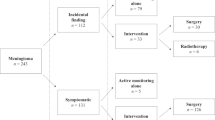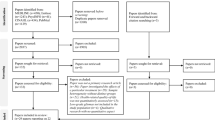Abstract
Purpose
Survivors of paediatric intracranial tumours are at increased risk of psychosocial, neuro-developmental, and functional impairment. This study aimed to evaluate long-term health-related quality-of-life (HRQOL) outcomes in patients with benign paediatric brain tumours treated curatively with surgical resection alone.
Methodology
This was a cross-sectional study of patients with benign paediatric intracranial tumours managed with surgery alone between 2000 and 2015. Eligible patients with a minimum of 5-years follow-up after surgery were identified. Validated health-related quality of life (HRQOL) questionnaires were administered: SF-36, QLQ-BN20, QLQ-C30 and PedsQL™.
Results
Twenty-three patients participated (median age at surgery 13 years; range 1–18; 12 male). The most common diagnosis was pilocytic astrocytoma (n = 15). Median time from surgery to participation was 11 years(range 6–19). Fourteen patients achieved A-level qualifications and two obtained an undergraduate degree. Twelve patients were employed, eight were studying and three were unemployed or volunteering. HRQOL outcomes demonstrated significant limitation from social functioning (p = 0.03) and cognitive functioning (p = 0.023) compared to the general population. Patients also experienced higher rates of loss of appetite (p = 0.009) and nausea and vomiting (p = 0.031). Ten patients were under transitional teenager and young-adult (TYA) clinic follow-up. TYA patients achieved higher levels of education (p = 0.014), were more likely to hold a driver’s license (p = 0.041) compared to patients not followed-up through these services.
Conclusions
Childhood brain-tumour survivors have a greater risk of developing psychological, neuro-cognitive and physical impairment. Early comprehensive assessment, specialist healthcare and TYA services are vital to support these patients.

Similar content being viewed by others
Data availability
Anonymized data are available (upon reasonable request) from the corresponding author.
References
Bayne, C.S.N.D.T.V.A., National Registry of Childhood Tumours Progress Report, T. NCIN Children and a.Y.A.C.R.G.C. CRG), Editors. 2012, Childhood Cancer Research Group (CCRG): United Kingdom.
Bell H et al (2018) A systematic review of factors related to children’s quality of life and mental health after brain tumor. Psychooncology 27(10):2317–2326
Macartney G et al (2014) Quality of life and symptoms in pediatric brain tumor survivors: a systematic review. J Pediatr Oncol Nurs 31(1532–8457):65–77
Warren KE (2012) Diffuse intrinsic pontine glioma: poised for progress. Front Oncol 2:205–205
Packer RJ (2008) Childhood brain tumors: accomplishments and ongoing challenges. J Child Neurol 23(1708–8283):1122–1127
Karajannis M, Allen JC, Newcomb EW (2008) Treatment of pediatric brain tumors. J Cell Physiol. https://doi.org/10.1002/jcp.21544
Due-Tønnessen BJ et al (2002) Long-term outcome after resection of benign cerebellar astrocytomas in children and young adults (0–19 years): report of 110 consecutive cases. Paediatric Neurosurg 37(1016–2291):71–80
Bampoe J, Siomin V, Bernstein M (2002) Quality of life assessment in neurosurgical patients. Neurosurg Q 12:132–141
Foster MT et al (2021) Reporting morbidity associated with pediatric brain tumor surgery: are the available scoring systems sufficient? J Neurosurg Pediatr 27(5):556–565
Efficace F, Bottomley A (2003) Assessing HRQOL: a neglected issue for high-grade glioma. Lancet Oncol 4(1):11–12
Armstrong GT et al (2009) Long-term outcomes among adult survivors of childhood central nervous system malignancies in the childhood cancer survivor study. J Natl Cancer Inst. https://doi.org/10.1093/jnci/djp148
Mostow EN et al (1991) Quality of life in long-term survivors of CNS tumors of childhood and adolescence. J Clin Oncol 9(0732–183X):592–599
Vannatta K et al (1998) A controlled study of peer relationships of children surviving brain tumors: teacher, peer, and self ratings. J Paediatr Psychol. https://doi.org/10.1093/jpepsy/23.5.279
Armstrong GT et al (2010) Survival and long-term health and cognitive outcomes after low-grade glioma. Neuro Oncol 1523–5866:1–12
Duffner PK, Cohen ME, Thomas P (1983) Late effects of treatment on the intelligence of children with posterior fossa tumors. Cancer 51(2):233–237
Carpentieri SC et al (2003) Neuropsychological functioning after surgery in children treated for brain tumor. J Neurosurg 52(0148–396):1348–1357
Mulhern RK et al (2004) Late neurocognitive sequelae in survivors of brain tumours in childhood. Lancet Oncol. https://doi.org/10.1016/S1470-2045(04)01507-4
Glauser TA, Packer RJ (1991) Cognitive deficits in long-term survivors of childhood brain tumors. Child’s Nerv Syst 7:2–12
Oeffinger KC et al (2000) Grading of late effects in young adult survivors of childhood cancer followed in an ambulatory adult setting. Cancer 88(0008–543X):1687–1695
Reimers TS et al (2003) Cognitive deficits in long-term survivors of childhood brain tumors: Identification of predictive factors. Med Pediatr Oncol 40(1):26–34
Sønderkær S et al (2003) Long-term neurological outcome of childhood brain tumors treated by surgery only. J Clin Oncol 21(7):1347–1351
Moher D et al (2009) Preferred reporting items for systematic reviews and meta-analyses: the PRISMA statement. BMJ 339:b2535
Ware JE Jr., Sherbourne CD, The MOS 36-item short-form health survey (SF-36). I. Conceptual framework and item selection. Medical Care 30(6):473–483. http://www.jstor.org/stable/3765916
Aaronson NK et al (1993) The European Organisation for Research and Treatment of Cancer QLQ-C30: a quality-of-life instrument for use in international clinical trials in oncology. J Natl Cancer Inst 85:365–376
Taphoorn MJ, Claassens L, Aaronson NK, Coens C, Mauer M, Osoba D, Stupp R, Mirimanoff RO, van den Bent MJ, Bottomley A (2010) EORTC Quality of Life Group, and Brain Cancer, NCIC and Radiotherapy Groups. An international validation study of the EORTC brain cancer module (EORTC QLQ-BN20) for assessing health-related quality of life and symptoms in brain cancer patients. Eur J Cancer 46(6):1033–1040
Varni JW, Seid M, Kurtin PS (2001) PedsQL 4.0: reliability and validity of the Pediatric Quality of Life Inventory version 4.0 generic core scales in healthy and patient populations. Medical care 39(8):800–812. https://doi.org/10.1097/00005650-200108000-00006
Welsh Health Survey, W.G. Information on general health status and illnesses among adults in Wales. 2015; Available from: https://statswales.gov.wales/Catalogue/Health-and-Social-Care/Welsh-Health-Survey/sf36-by-gender-year.
Neil W Scott, P.M.F., Neil K Aaronson, Andrew, et al., EORTC QLQ-C30 Reference Values in EORTC Quality of Life Group. 2008, Quality of Life Department, EORTC Headquarters.
Chan EK, Edwards TC, Haywood K, Mikles SP, Newton L (2018) Implementing patient-reported outcome measures in clinical practice: a companion guide to the ISOQOL user’s guide. Intern Soc Qual Life Res 28:621–627
Uhlig K, Menon V, Schmid CH (2007) Recommendations for reporting of clinical research studies. Am J Kidney Dis Off J Natl Kidney Found 49: 1, 3–7
Musiol K, Bulska W, Brożek P, Oślizło B, Ryzak S, Dubiel J, Sobol-Milejska G (2019) Quality of life in survivors of childhood brain tumour and the association of children’s diseases on quality of their parents life. Psycho Oncol 28(5):1088–1095
Speechley KN et al (2006) Health-related quality of life among child and adolescent survivors of childhood cancer. J Clin Oncol 24(16):2536–2543
Schulte F et al (2017) Systematic review and meta-analysis of health-related quality of life in pediatric CNS tumor survivors. Pediatr Blood Cancer 64(8):e26442
Mason J, Danby S (2011) Children as experts in their lives: child inclusive research. Child Indic Res 4(2):185–189
Aquilina K (2013) Posterior fossa tumours in children: an overview of diagnosis and management. Adv Clin Neurosci Rehabil 13(4):24–28
Ramanan M, Chaseling R (2012) Paediatric brain tumours treated at a single, tertiary paediatric neurosurgical referral centre from 1999 to 2010 in Australia. J Clin Neurosci 19(10):1387–1391
Knight J, D.J.O., Pilocytic Astrocytoma. StatPearls, 2021.
Hasan M et al (2020) Analysis of factors that influence neurosurgical length of hospital stay among newly diagnosed pediatric brain tumor patients. Pediatr Blood Cancer 67(1):e28041
GPS, E., Overview of the education system (EAG 2021). 2021, Organisation for Economic Co-operation and Development (OECD).
Oeffinger KC et al (2006) Chronic health conditions in adult survivors of childhood cancer. N Engl J Med 355(15):1572–1582
Vanclooster S et al (2019) Reintegration into school after treatment for a brain tumor: the Child’s Perspective. Global Pediatr Health 6:2333794X1986065
Sato I et al (2018) Employment status and termination among survivors of pediatric brain tumors: a cross-sectional survey. Int J Clin Oncol 23(5):801–811
Wong J et al (2009) Symptoms and quality of life in cancer patients with brain metastases following palliative radiotherapy. Int J Radiat Oncol Biol Phys 75(4):1125–1131
Chow E et al (2005) Prospective assessment of patient-rated symptoms following whole brain radiotherapy for brain metastases. J Pain Symptom Manage 30(1):18–23
Yaneva MP, Semerdjieva MA (2006) Assessment of the effect of palliative radiotherapy for cancer patients with intracranial metastases using EORTC-QOL-C30 questionnaire. Folia Med 48(2):23–29
Yucel B, Akkaş EA, Okur Y, Eren AA, Eren MF, Karapınar H, Babacan NA, Kılıçkap S (2014) The impact of radiotherapy on quality of life for cancer patients: a longitudinal study. Supportive Care Cancer 22(9):2479–2487
Pogorzala M et al (2010) Health-related quality of life among paediatric survivors of primary brain tumours and acute leukaemia. Qual Life Res 19(2):191–198
Eiser C, Vance YH, Horne B, Glaser A, Galvin H (2003) The value of the PedsQLTM in assessing quality of life in survivors of childhood cancer. Child Care Health Dev 29(2):95–102
Macartney G et al (2014) Symptom experience and quality of life in pediatric brain tumor survivors: a cross-sectional study. J Pain Symptom Manage 48(5):957–967
Kohler BE et al (2021) Physical ACTivity in Survivorship (PACTS): study protocol for a randomized controlled trial evaluating a goal-directed therapeutic exercise program in pediatric posterior fossa brain tumor survivors. BMC Pediatr. https://doi.org/10.1186/s12887-021-02566-7
Klosky JL et al (2008) Factors influencing long-term follow-up clinic attendance among survivors of childhood cancer. J Cancer Surviv 2(4):225–232
Runco DV et al (2019) Nutrition & exercise interventions in pediatric patients with brain tumors: a narrative review. JNCI Monographs 2019(54):163–168
Meeske KA, Patel SK, Palmer SN, Nelson MB, Parow AM (2007) Factors associated with health-related quality of life in pediatric cancer survivors. Paediatr Blood Cancer 49(3):298–305
Eilertsen ME, Jozefiak T, Rannestad T, Indredavik MS, Vik T (2012) Quality of life in children and adolescents surviving cancer. Eur J Oncol Nurs 16:185–193
Mock V, Atkinson A, Barsevick A, Cella D, Cimprich B, Cleeland C, Donnelly J, Eisenberger MA, Escalante C, Hinds P, Jacobsen PB (2000) National Comprehensive Cancer Network (NCCN) practice guidelines for cancer-related fatigue. Oncol J 14(11A):151–161
Richardson RC, Nelson MB, Meeske K (1999) Young adult survivors of childhood cancer: attending to emerging medical and psychosocial needs. J Pediatr Oncol Nurs 16(3):136–144
Funding
This research did not receive any specific grant from funding agencies in the public, commercial, or not-for-profit sectors.
Author information
Authors and Affiliations
Contributions
Conception and design: RM, CLM, MDJ. Data collection: SK, RM, CPM, MTF, CM, BP Data analysis: SK, AI. Data interpretation: SK, AI, RM, CPM, DH, MTF, BP, CLM, MDJ. Manuscript writing, revision, and completion: all authors.
Corresponding author
Ethics declarations
Competing interests
The authors have no conflicts of interest to declare that are relevant to the content of this article.
Ethical approval
This study was approved by the East of England Essex Research Ethics Committee (REC No. 18/EE/0225).
Consent for publication
Not required.
Additional information
Publisher's Note
Springer Nature remains neutral with regard to jurisdictional claims in published maps and institutional affiliations.
Supplementary Information
Below is the link to the electronic supplementary material.
Rights and permissions
Springer Nature or its licensor (e.g. a society or other partner) holds exclusive rights to this article under a publishing agreement with the author(s) or other rightsholder(s); author self-archiving of the accepted manuscript version of this article is solely governed by the terms of such publishing agreement and applicable law.
About this article
Cite this article
Kumar, S., Islim, A.I., Moon, R. et al. Long term quality of life outcomes following surgical resection alone for benign paediatric intracranial tumours. J Neurooncol 161, 77–84 (2023). https://doi.org/10.1007/s11060-022-04208-z
Received:
Accepted:
Published:
Issue Date:
DOI: https://doi.org/10.1007/s11060-022-04208-z




